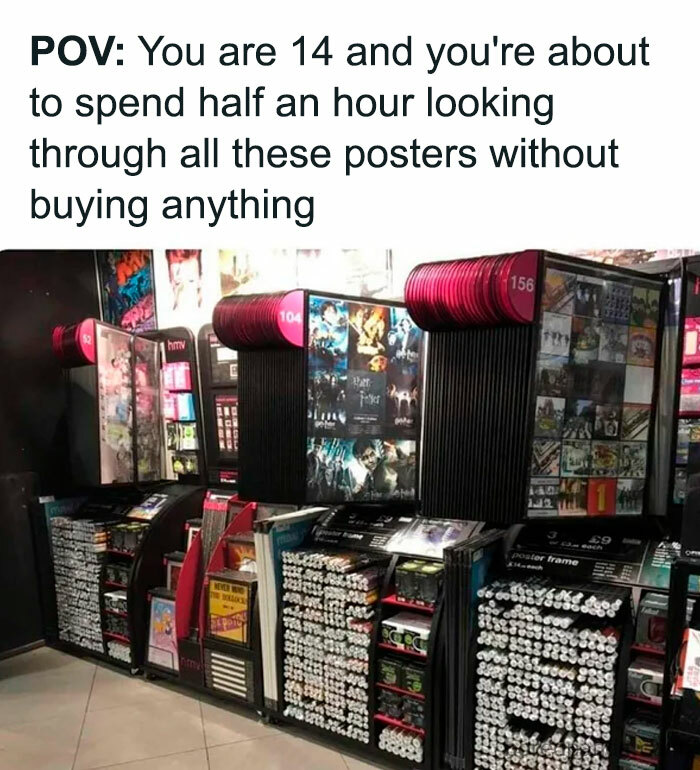The first Bondi blue iMac, Sillybandz, and trading Pokémon cards. Feeling nostalgic yet? These three things have one characteristic in common: they were all around when millennials were kids. As most of our likes and dislikes come from childhood impressions, those who grew up in the '90s will always have a soft spot for these things.
Luckily, there are pages online that preserve our memory of this iconic decade. Like the "I was born in the 1990s" Facebook page, dedicated to nostalgic content relevant to that era. With its 1 million followers, it boasts a community of like-minded '90s kids hungry for a taste of their wonderful formative years.
Since everything these days seems to be about nostalgia, from movie remakes to old-school Nokias coming back in style, Bored Panda sought some expertise about using '90s nostalgia in marketing. Social media marketing guru Peg Fitzpatrick kindly agreed to tell us more about the power of the '90s in marketing. Read her expert insights below!
More info: Peg Fitzpatrick | The Art Of Small Business Social Media | Instagram
This post may include affiliate links.
"Nostalgia is like a time-traveling magnet for consumer behavior," says Peg Fitzpatrick, a social media marketing consultant for small businesses. "It doesn't just tug at heartstrings; it wraps them around entire marketing strategies."
"People love revisiting the '90s because it was a simpler time of slap bracelets and dial-up internet—nostalgia taps into that longing for the good ol' days. Social media marketers can wield this powerful tool by creating content that resonates with these fond memories, from throwback ads to retro-themed product launches. After all, who wouldn't want to relive the days of TGIF and neon scrunchies?" Peg asks.
"Nostalgia isn't just a wistful glance in the rearview mirror; it's a powerhouse in consumer behavior that marketers can't ignore," Peg explains the psychology behind using nostalgia for marketing.
"It taps into our innate desire for connection and comfort, transporting us back to when things seemed simpler and more carefree. Whether it's reminiscing about Saturday morning cartoons or the thrill of collecting Pokémon cards, nostalgia evokes strong emotions and a sense of longing for the past."
According to Fitzpatrick, nostalgia works so well in marketing because it feels so personal. "From a marketing perspective, nostalgia serves as a powerful tool to engage audiences on a deeper level."
"Brands can leverage nostalgia to create authentic connections with consumers by tapping into shared cultural experiences and memories. This can be seen in campaigns that resurrect iconic '90s brands or icons, evoking a sense of familiarity and nostalgia that resonates with both longtime fans and younger generations," Peg points out.
Nostalgia is also a good way to build brand loyalty. "When consumers associate positive emotions with a brand's nostalgic elements, they are more likely to develop a strong affinity for that brand and remain loyal over time," Peg explains. "This emotional connection goes beyond product features or pricing—it's about fostering a relationship built on shared experiences and values."
Social media makes it even easier for brands to harvest nostalgia. "[It allows] brands to engage with consumers in real-time conversations about their favorite memories and cultural touchstones," Peg says.
"Whether through throwback posts, retro-themed campaigns, or limited-edition reissues of classic products, marketers can create immersive brand experiences that tap into the universal appeal of nostalgia."
"Ultimately, nostalgia in marketing isn't just about looking back; it's about creating meaningful connections that resonate with consumers' emotions and values," Peg emphasizes. "By harnessing the power of nostalgia responsibly and authentically, brands can turn fond memories into enduring brand loyalty and advocacy."
I think millenials (Gen X and Y) understand this much better than boomers.
Surprisingly, those born in the 2000s and even the 2010s love the '90s, too. They're as responsive (if not more) to '90s nostalgia campaigns as millennials are. The pop music "It" girl of Gen Z, Olivia Rodrigo, for example, masterfully uses her love for the '90s aesthetics both in her music and in her marketing campaigns.
Fake cheese! Enriched white flour! Processed mystery meat by-products!
Peg takes Ulta Beauty's Hello Kitty campaign as another example. According to her, it exemplifies the art of blending timeless appeal with contemporary flair. "From themed makeup collections to skincare products adorned with Hello Kitty motifs, these campaigns capture the hearts of both longtime fans and new audiences alike."
"By tapping into cultural icons that transcend generations, brands can forge connections that go beyond mere consumerism, fostering a sense of nostalgia and community."
So, do the '90s no longer belong to the people who actually grew up in the nineties? "Demographics in '90s nostalgia are as diverse as a Saved by the Bell reunion episode," Peg quips.
"Sure, millennials who grew up with Game Boys and Tamagotchis are prime targets. But don't underestimate the allure for Gen Z and even Gen Xers—they're all craving a taste of that Walkman-wearing, Beanie Baby-collecting era."
Flip phones, Tamagotchis, and cassettes coming back in fashion has little to do with when people were born, apparently. "Nostalgia in marketing isn't just about age," Peg confirms. "It's about tapping into shared cultural touchstones that transcend generations. After all, who doesn't smile at the thought of Blockbuster Friday nights and dial-up internet woes?"
When I was a kid I wanted an Omnibot2000. That thing was the future!
Must have UK and America because I remember most of these well.
Load More Replies...I am the right age, mostly. I grew up in the late 80s. But I'm too foreign. Nobody would have had access to any of these things unless they were super wealthy. Plastic toys didn't come until we started trading with China in the mid-late 90s. And electronic toys were too expensive for most families.
Load More Replies...When I was a kid, we played with rocks and sticks. Our house had one phone, it was plugged into the wall, it has a rotary dial on it and we weren't allowed to use it because local calls cost money back then.
When I was a young kid we did too. I spent a lot of time with my aunt, she had converted an old school bus and her and my uncle lived out in the middle of nowhere. This was back in the 80's, before this huge trend hit. There were no tvs, electricity, phones. We used our imaginations. Made forts, bows and arrows, found gun shaped sticks for hunting.
Load More Replies...I wouldn’t say a lot, but it was nice to see a few that made sense for once though!
Load More Replies...Must have UK and America because I remember most of these well.
Load More Replies...I am the right age, mostly. I grew up in the late 80s. But I'm too foreign. Nobody would have had access to any of these things unless they were super wealthy. Plastic toys didn't come until we started trading with China in the mid-late 90s. And electronic toys were too expensive for most families.
Load More Replies...When I was a kid, we played with rocks and sticks. Our house had one phone, it was plugged into the wall, it has a rotary dial on it and we weren't allowed to use it because local calls cost money back then.
When I was a young kid we did too. I spent a lot of time with my aunt, she had converted an old school bus and her and my uncle lived out in the middle of nowhere. This was back in the 80's, before this huge trend hit. There were no tvs, electricity, phones. We used our imaginations. Made forts, bows and arrows, found gun shaped sticks for hunting.
Load More Replies...I wouldn’t say a lot, but it was nice to see a few that made sense for once though!
Load More Replies...
 Dark Mode
Dark Mode 

 No fees, cancel anytime
No fees, cancel anytime 



































































































































